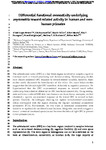Differential functional connectivity underlying asymmetric reward-related activity in human and nonhuman primates
| dc.contributor.author | Lopez-Persem, A | |
| dc.contributor.author | Roumazeilles, L | |
| dc.contributor.author | Folloni, D | |
| dc.contributor.author | Marche, K | |
| dc.contributor.author | Fouragnan, Elsa | |
| dc.contributor.author | Khalighinejad, N | |
| dc.contributor.author | Rushworth, MFS | |
| dc.contributor.author | Sallet, J | |
| dc.date.accessioned | 2021-11-05T12:29:09Z | |
| dc.date.available | 2021-11-05T12:29:09Z | |
| dc.date.issued | 2020-11-10 | |
| dc.identifier.issn | 0027-8424 | |
| dc.identifier.issn | 1091-6490 | |
| dc.identifier.uri | http://hdl.handle.net/10026.1/18239 | |
| dc.description.abstract |
<jats:p>The orbitofrontal cortex (OFC) is a key brain region involved in complex cognitive functions such as reward processing and decision making. Neuroimaging studies have reported unilateral OFC response to reward-related variables; however, those studies rarely discussed this observation. Nevertheless, some lesion studies suggest that the left and right OFC contribute differently to cognitive processes. We hypothesized that the OFC asymmetrical response to reward could reflect underlying hemispherical difference in OFC functional connectivity. Using resting-state and reward-related functional MRI data from humans and from rhesus macaques, we first identified an asymmetrical response of the lateral OFC to reward in both species. Crucially, the subregion showing the highest reward-related asymmetry (RRA) overlapped with the region showing the highest functional connectivity asymmetry (FCA). Furthermore, the two types of asymmetries were found to be significantly correlated across individuals. In both species, the right lateral OFC was more connected to the default mode network compared to the left lateral OFC. Altogether, our results suggest a functional specialization of the left and right lateral OFC in primates.</jats:p> | |
| dc.format.extent | 28452-28462 | |
| dc.format.medium | Print-Electronic | |
| dc.language | en | |
| dc.language.iso | en | |
| dc.publisher | Proceedings of the National Academy of Sciences | |
| dc.subject | orbitofrontal cortex | |
| dc.subject | reward | |
| dc.subject | functional connectivity | |
| dc.subject | lateralization | |
| dc.title | Differential functional connectivity underlying asymmetric reward-related activity in human and nonhuman primates | |
| dc.type | journal-article | |
| dc.type | Journal Article | |
| dc.type | Research Support, N.I.H., Extramural | |
| dc.type | Research Support, Non-U.S. Gov't | |
| plymouth.author-url | https://www.webofscience.com/api/gateway?GWVersion=2&SrcApp=PARTNER_APP&SrcAuth=LinksAMR&KeyUT=WOS:000591072400006&DestLinkType=FullRecord&DestApp=ALL_WOS&UsrCustomerID=11bb513d99f797142bcfeffcc58ea008 | |
| plymouth.issue | 45 | |
| plymouth.volume | 117 | |
| plymouth.publication-status | Published | |
| plymouth.journal | Proceedings of the National Academy of Sciences | |
| dc.identifier.doi | 10.1073/pnas.2000759117 | |
| plymouth.organisational-group | /Plymouth | |
| plymouth.organisational-group | /Plymouth/Faculty of Health | |
| plymouth.organisational-group | /Plymouth/Faculty of Health/School of Psychology | |
| plymouth.organisational-group | /Plymouth/REF 2021 Researchers by UoA | |
| plymouth.organisational-group | /Plymouth/REF 2021 Researchers by UoA/UoA04 Psychology, Psychiatry and Neuroscience | |
| plymouth.organisational-group | /Plymouth/Users by role | |
| plymouth.organisational-group | /Plymouth/Users by role/Academics | |
| plymouth.organisational-group | /Plymouth/Users by role/Researchers in ResearchFish submission | |
| dc.publisher.place | United States | |
| dcterms.dateAccepted | 2020-09-16 | |
| dc.rights.embargodate | 2021-11-9 | |
| dc.identifier.eissn | 1091-6490 | |
| dc.rights.embargoperiod | Not known | |
| rioxxterms.versionofrecord | 10.1073/pnas.2000759117 | |
| rioxxterms.licenseref.uri | http://www.rioxx.net/licenses/all-rights-reserved | |
| rioxxterms.licenseref.startdate | 2020-11-10 | |
| rioxxterms.type | Journal Article/Review |


